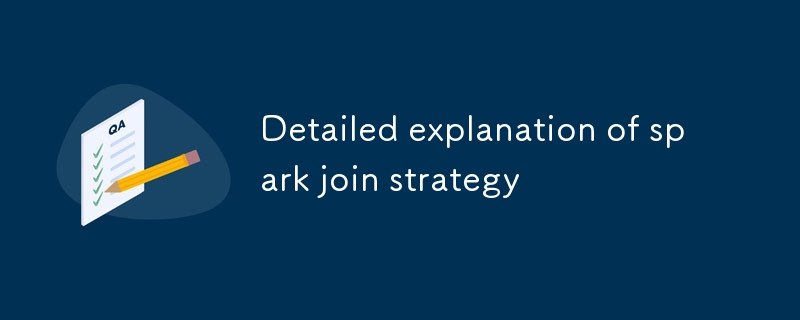Detailed explanation of spark join strategy
- DDDOriginal
- 2024-08-15 14:39:45655browse
This article discusses Apache Spark's join strategies to optimize join operations. It details the Broadcast Hash Join (BHJ), Sort Merge Join (SMJ), and Shuffle Hash Join (SHJ) strategies. The article emphasizes choosing the appropriate strategy based

What are the different join strategies available in Spark and when should each be used?
Apache Spark provides several join strategies to optimize the performance of join operations based on the characteristics of the data and the specific workload. These strategies include:
- Broadcast Hash Join (BHJ): BHJ is suitable when one of the input datasets is significantly smaller than the other. It broadcasts the smaller dataset to all executors, allowing for efficient lookups during the join operation. BHJ is recommended when the smaller dataset fits entirely in the memory of the executors.
- Sort Merge Join (SMJ): SMJ is ideal when both input datasets are large and cannot fit in memory. It sorts both datasets on the join key and then merges them to perform the join operation. SMJ requires additional memory and I/O resources for sorting.
- Shuffle Hash Join (SHJ): SHJ is a variant of BHJ that is used when the smaller dataset is too large to broadcast but still fits in the memory of a single executor. SHJ partitions the smaller dataset and distributes it across the executors, allowing for efficient hash lookups during the join operation.
How can I tune the join strategy to optimize performance for my specific workload?
To optimize the performance of join operations in Spark, you can consider the following strategies:
- Dataset Size: Analyze the sizes of the input datasets and choose the join strategy that is most appropriate based on the relative size of the datasets.
- Memory Availability: Assess the amount of memory available on your executors and consider the memory requirements of each join strategy. BHJ is more memory-intensive than SMJ, while SHJ offers a trade-off between memory consumption and efficiency.
- Join Key Distribution: Determine the distribution of values in the join key and consider the join strategy that is most efficient for the given distribution. If the join key has a skewed distribution, SHJ may be more suitable to handle the skew.
- Workload Characteristics: Consider the specific workload and the characteristics of your data. For example, if you are performing iterative joins or have complex join conditions, SMJ may be more appropriate.
What are the trade-offs between different join strategies in terms of performance, memory usage, and scalability?
The different join strategies in Spark offer varying trade-offs in terms of performance, memory usage, and scalability:
- Performance: BHJ is generally the most performant option when the smaller dataset can be broadcast to all executors. SMJ is less performant due to the additional I/O and sorting overhead.
- Memory Usage: BHJ requires more memory for broadcasting the smaller dataset. SMJ requires less memory but may have higher memory requirements if the datasets are large. SHJ offers a balance between memory usage and performance.
- Scalability: BHJ scales linearly with the size of the larger dataset. SMJ scales well with both large and small datasets. SHJ's scalability is limited by the memory available on individual executors.
The above is the detailed content of Detailed explanation of spark join strategy. For more information, please follow other related articles on the PHP Chinese website!

